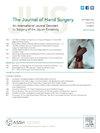The Effect of Elbow Flexion On Valgus Carrying Angle
IF 2.1
2区 医学
Q2 ORTHOPEDICS
引用次数: 0
Abstract
Purpose
This study aimed to examine the effect of flexion on valgus carrying angle in the human elbow using a dynamic elbow testing apparatus.
Methods
Active elbow motion was simulated in seven cadaveric upper extremities. Six electromechanical actuators simulated muscle action, while 6 degrees-of-freedom joint motion was measured with an optical tracking system to quantify the kinematics of the ulna with respect to the humerus as the elbow was flexed at the side position. Repeatability of the testing apparatus was assessed in a single elbow over five flexion-extension cycles. The varus angle change of each elbow was compared at different flexion angles with the arm at 0° of humerothoracic abduction or dependent arm position.
Results
The testing apparatus achieved excellent kinematic repeatability (intraclass correlation coefficient, >0.95) throughout flexion and extension. All elbows decreased their valgus carrying angle during flexion from 0° to 90° when the arm was maintained at 0° of humerothoracic abduction. Elbows underwent significant total varus angle change from full extension of 3.9° ± 3.4° (P = .007), 7.3° ± 5.2° (P = .01), and 8.9° ± 7.1° (P = .02) at 60°, 90°, and 120° of flexion, respectively. No significant varus angle change was observed between 0° and 30° of flexion (P = .66), 60° and 120° of flexion (P = .06), and 90° and 120° of flexion (P = .19).
Conclusions
The dynamic elbow testing apparatus characterized a decrease of valgus carrying angle during elbow flexion and found that most varus angle changes occurred between 30° and 90° of flexion. All specimens underwent varus angle change until at least 90° of flexion.
Clinical relevance
Our model establishes the anatomic decrease in valgus angle by flexion angle in vitro and can serve as a baseline for testing motion profiles of arthroplasty designs and ligamentous reconstruction in the dependent arm position. Future investigations should focus on characterizing motion profile change as the arm is abducted away from the body.
肘关节屈曲对外翻搬运角度的影响。
目的:本研究旨在探讨屈曲对人体肘关节外翻携带角的影响。方法:模拟7条尸体上肢肘部主动运动。6个机电致动器模拟肌肉运动,而6个自由度的关节运动用光学跟踪系统测量,以量化肘关节侧屈时尺骨相对于肱骨的运动学。测试设备的重复性在单个肘关节的五个屈伸循环中进行评估。比较不同屈曲角度下各肘关节内翻角的变化,臂位为0°肱骨胸外展或依赖臂位。结果:测试仪器在整个屈伸过程中具有优异的运动重复性(类内相关系数>0.95)。当手臂保持肱骨胸外展0°时,所有肘关节在屈曲时的外翻携带角从0°减小到90°。肘关节在屈曲60°、90°和120°时,分别发生了3.9°±3.4°(P = 0.007)、7.3°±5.2°(P = 0.01)和8.9°±7.1°(P = 0.02)的明显内翻角变化。0°和30°屈曲(P = 0.66)、60°和120°屈曲(P = 0.06)、90°和120°屈曲(P = 0.19)均未观察到明显的内翻角变化。结论:动态肘关节测试仪检测到肘关节屈曲过程中外翻携带角减小,发现屈曲30°~ 90°范围内外翻角度变化最多。所有标本均发生内翻角度改变,直至屈曲至少90°。临床意义:我们的模型通过体外屈曲角度建立了外翻角的解剖减少,可以作为测试关节置换术设计和韧带重建在依赖臂位的运动特征的基线。未来的研究应侧重于描述手臂被绑架离开身体时的运动轮廓变化。
本文章由计算机程序翻译,如有差异,请以英文原文为准。
求助全文
约1分钟内获得全文
求助全文
来源期刊
CiteScore
3.20
自引率
10.50%
发文量
402
审稿时长
12 weeks
期刊介绍:
The Journal of Hand Surgery publishes original, peer-reviewed articles related to the pathophysiology, diagnosis, and treatment of diseases and conditions of the upper extremity; these include both clinical and basic science studies, along with case reports. Special features include Review Articles (including Current Concepts and The Hand Surgery Landscape), Reviews of Books and Media, and Letters to the Editor.

 求助内容:
求助内容: 应助结果提醒方式:
应助结果提醒方式:


